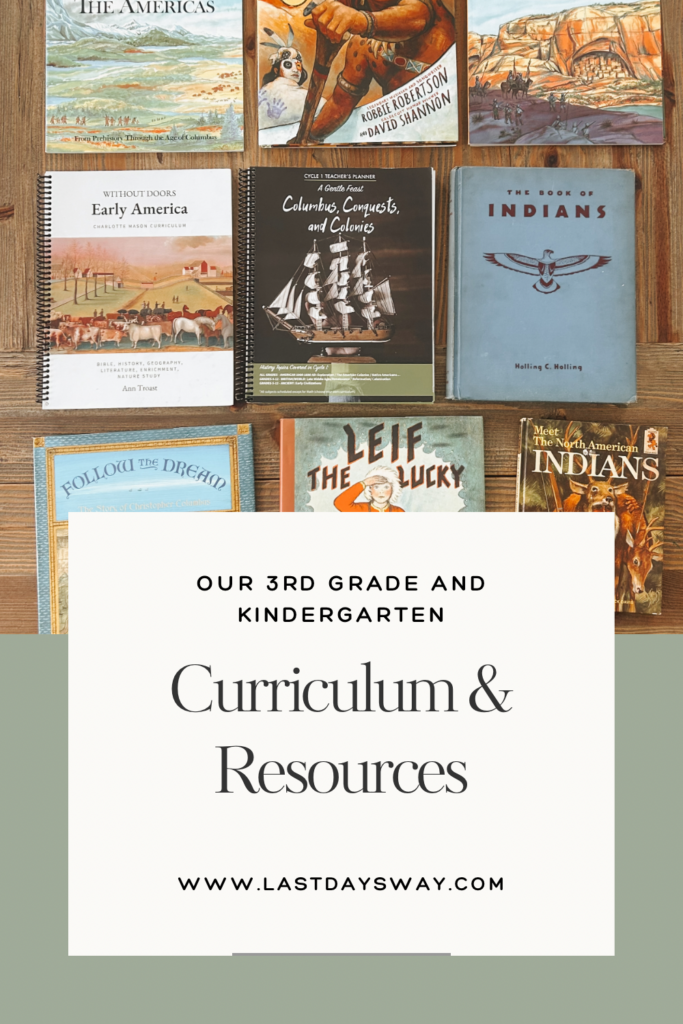
The Holy Spirit has been so clear with what He wants our family to focus on this year. I’m not immune to the onslaught of FOMO when everyone starts sharing what they’re using- but knowing that we’ve heard His voice keeps us laser focused and content.
When I wrote A Spirit-led Guide to Homeschooling, I wrote it first to myself. Outlining exactly what the Holy Spirit desires for our specific homeschool was so vital, since He was the one who called me to homeschooling in the first place. In the guide, I talk about creating a foundational Scripture, and then establishing “pillars.” If the foundational Scripture could be compared the the foundation of a house, the pillars would be compared to the walls. The walls create boundaries, direction, clear pathways. Here are the pillars the Holy Spirit gave us for our homeschool, Maranatha Academy:
- Jesus and His Kingdom- Bible/Church History/Equipping and Discipleship
- Wilderness Study- Nature Study/Wilderness
- Worship -The Arts, Hymns, Instruments, Voice
- Trades and Skills- Homemaking Skills and Trades
- Language- Read, Written, Foreign, Public Speaking
- Wellness and Fitness
- Critical Thinking (through History, Geography, Logic, Math)
If I go astray, the Holy Spirit always brings me back to these. If these are being covered, even if done so gently, then I am doing what He’s asked me to do. For this reason, instead of dividing this year’s curriculum choices into typical subjects, I’m going to divide them into these pillars. This will help me look back and see, year by year, how I zoomed in on each area.
Jesus and His Kingdom
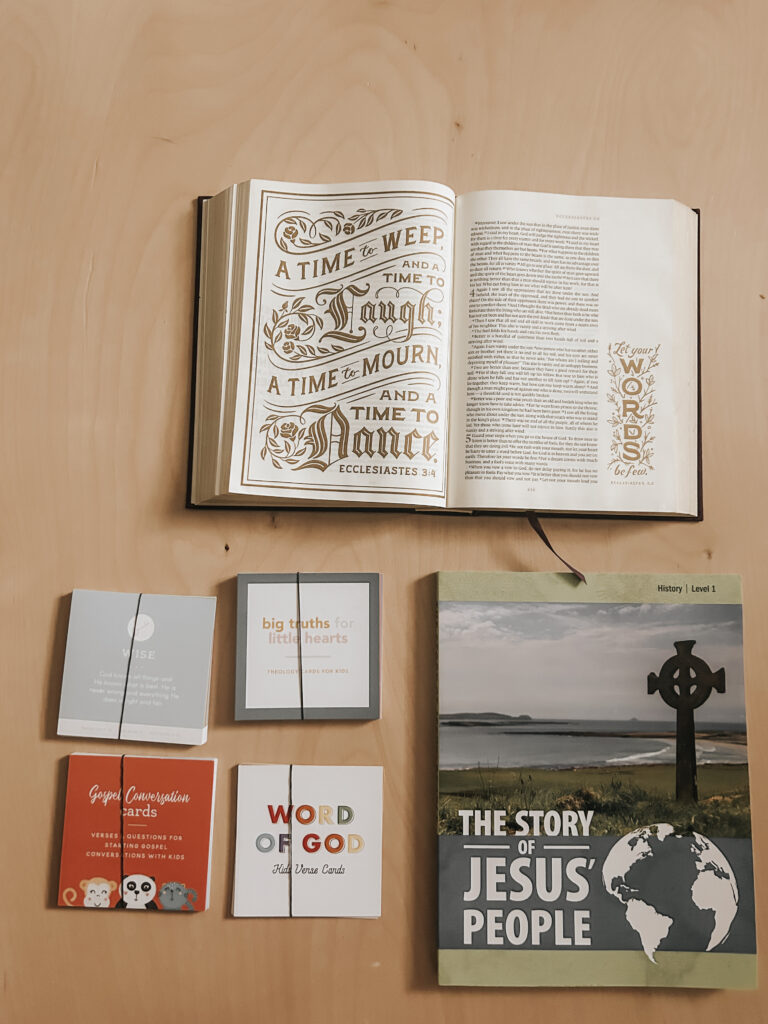
Bible
For Bible this year, we will be reading directly from the Word of God. The translation we typically use is ESV. We will be using A Gentle Feast Cycle 1 Morning Time‘s daily readings, which includes an Old Testament reading, a New Testament reading, a reading from the Psalms and a reading from Proverbs each week. After we read our daily portion, my 3rd grader will be required to narrate (tell back) what I read, and I will ask a few discussion questions to my Kindergartner. So, once again, these readings will look like:
Monday: OT Reading (starting in Genesis)
Tuesday: NT Reading (starting in Matthew)
Wednesday: Psalms (starting in the first chapter)
Thursday: Proverbs (starting in the first chapter)
Church History
On Fridays in place of “Bible,” we will be learning Church History. We will read one chapter every Friday of The Story of Jesus’ Church by Generations Curriculum. It is written at a first grade level, so I’m hoping that my 3rd grader as well as my Kindergartner will be able to glean knowledge and wisdom from the text and pictures. It’s crucial in my homeschool that my children hear stories of bravery, courage and endurance through persecution from the time they are little. As we study the early church, we are reminded of the type of believers that we want to become: fearless, bold and unshakeable pillars of Truth.
Scripture Memorization
For Scripture memory, we will be adhering to the A Gentle Feast Cycle 1 Morning Time resource, which focuses on memorizing large chunks of Scripture over the course of each term. There are three 12-week terms in a school year, so we will be learning three chunks, practicing throughout the year and performing each once at the end of each term.
Fables
Once a week after our Bible reading, we will be reading from Aesop’s Fables. These are sweet stories that teach powerful principles of good and evil and point to the character traits we want to possess.
Daily Equipping
In addition to the Bible readings, the Church History study and the Scripture Memory, I also wanted to journal here some things I aim to do in the day-to-day. I pray that one day I can look back at these blog posts and see the fruit of these seemingly mundane daily routines.
- Share the Gospel each time I have to discipline the children. They sinned, but because of the blood of Jesus and the New Covenant He laid out for us, they can be forgiven and made right with God.
- Remind them of Gospel truths when they are in the middle of sibling conflict. For example: Lately, the kids have been trying to be first in everything, making everything a competition and getting very angry in the midst. We’ve been talking about how in the Kingdom of God, those who prefer others are seen as first, while those who elevate themselves above others are seen as last.
- The children will not be allowed to play with friends if they are being unkind to one another. This is training them in the principle of leadership in the church and being “faithful with little.” If they cannot be faithful with their own siblings, they are not ready for the responsibility to stewarding other relationships and being faithful to those. Also, being a leader within the church requires excellence within the home (1 Tim 3). If you want to lead other people, you have to be leading well at home. My children are responsible for leading themselves. If they can’t lead themselves well with their brother and sister, once again, they are not ready for more relationships.
- Take Morning Prayer Walks. We strive for these a few days per week, but even once a week will do the trick. On our walks, we attempt to speak to every neighbor we see outside. If we don’t already know them, we attempt to learn their name and some things about them. When we get home from our walk, we sit in the driveway and pray for each neighbor we know and the ones we met that day. This usually leads to the children telling our neighbors, “we’ve been praying for you,” which is quite the surprise to them. These walks are an opportunity to teach the children evangelism, loving our neighbor (literally), and also the concepts of authority and territory. Our neighborhood is our territory, and we have authority to proclaim on earth as it is in Heaven right here in our zip code. The kids hear me praying aloud over our neighborhood coming to Christ, knowing Him deeply and following Him always. They are free to join in with me. At the same time, they are getting fresh air and exercise! This is such a power-packed practice, and I pray we do it consistently.
- Bedtime Prayers of Gratitude and Recitation. During bedtime, they children say what they’re grateful for that day and pray aloud. They also recite whatever we’re learning as a family at that time (usually whatever is being taught to the children at church). For example, we have been reciting The Lord’s Prayer and Jeremiah 29:11 recently. We may also use the Catechism Cards from Daily Grace Co., pictured above.
These are just a few practices, but now I’m realizing I need to do an entire post about this! Nevertheless, let’s move on.
Wilderness Study

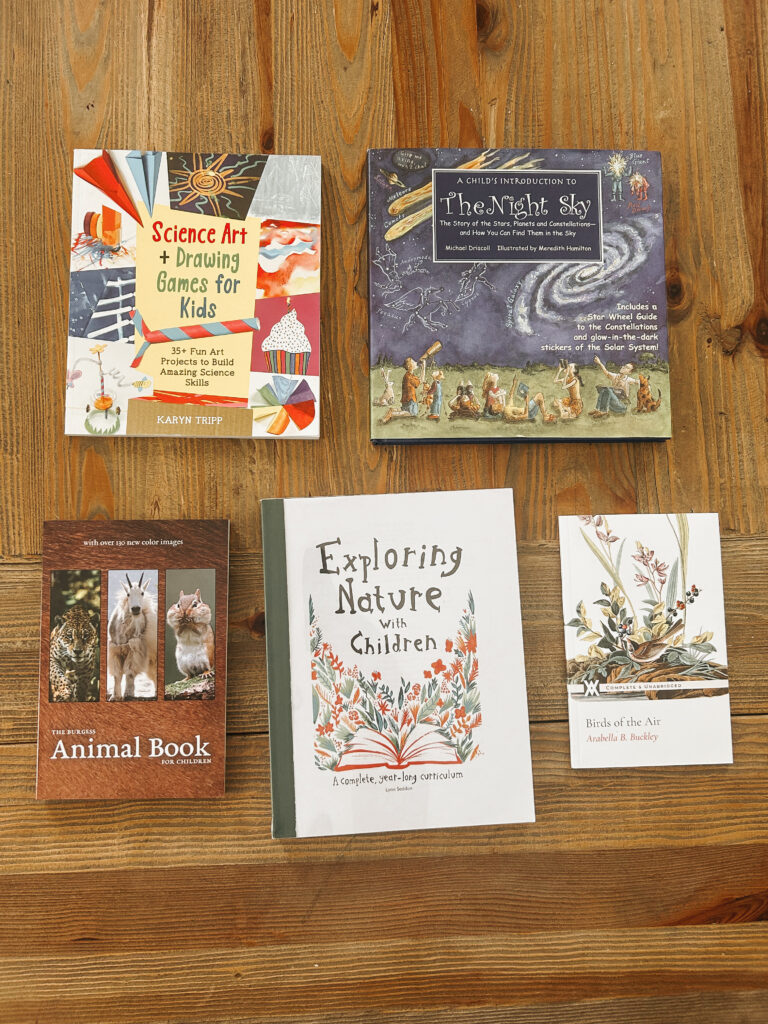
Our family has a real “last days” way of thinking, hence the name of this blog. That doesn’t mean we have years of stored food or bunkers, but it does mean that we feel very much so called to prepare our children spiritually and naturally for future persecution. It might not be my specific children that are not permitted to buy or sell, but it might be their children, or their grandchildren. Establishing normalcy around knowing what weeds are edible, which herbs help with what ailment, how to grow their own food, and how to source water and shelter are important life skills to pass down from generation to generation. This was second nature to our ancestors, but has gotten lost in modern culture. Do I believe they will live in some type of “wilderness” reality, needing to run through woods and live off the land? I’m not sure. Who knows! When the days come that the Church cannot buy or sell and has to band together like the Acts Church, depending on one another for everything, I want my children and their children to be able to offer many practical skills and much knowledge to the Church.
Nature Lore
“Nature Lore” can be defined as books that teach about God’s creation in a literary way, taught through story. The books we will be working through are The Burgess Animal Book for Children by Thornton Burgess and Birds of the Air by Arabella Buckley. The Thornton Burgess book will be read on Mondays, and the Arabella Buckley will be read on Thursdays. Birds of the Air is a super short book; so once we finish it, we will move on to A Child’s Introduction to the Night Sky by Michael Driscoll on Thursdays. Teaching the moon phases, stars and constellations to my children is something I feel convicted to do for survival reasons. I’m reminded of Harriet Tubman, who was taught by her father from a young age about the constellations, and used them (as well as knowledge of edible plants and herbal remedies) to lead hundreds of slaves to freedom via the Underground Railroad. Obviously, we aren’t learning the Zodiac to learn ANYTHING about ourselves (i.e. our zodiac sign), but rather we are learning the night sky to revel in God’s creation and to know it for directional purposes.
After reading a chapter of these aloud, my 3rd grader will narrate and then record what she’s learned in her notebook. My Kindergartner will be free to join in as she pleases. Learn more about how we do notebooking here.
Nature Study
This year, we will be working through Exploring Nature with Children on Fridays. Each week, we will do a nature walk during our normal “morning walk” time, focusing on the nature topic of the week. For example, if the weekly topic is insects, we will be looking for different bugs throughout our walk. Once we’re home, we will read a few nature books, either from the library or from our home collection on that week’s topic. In addition to Exploring Nature with Children (which works perfectly for my Kindergartner and Pre-schooler, we will also be using The Organic Studies from Idlewild and Company (JADAHITE for 10% off!) to deepen our studies for my 3rd grader. After reading a bit, we will journal about what we’ve learned in our nature journals. Here are some entries from last year’s nature study.
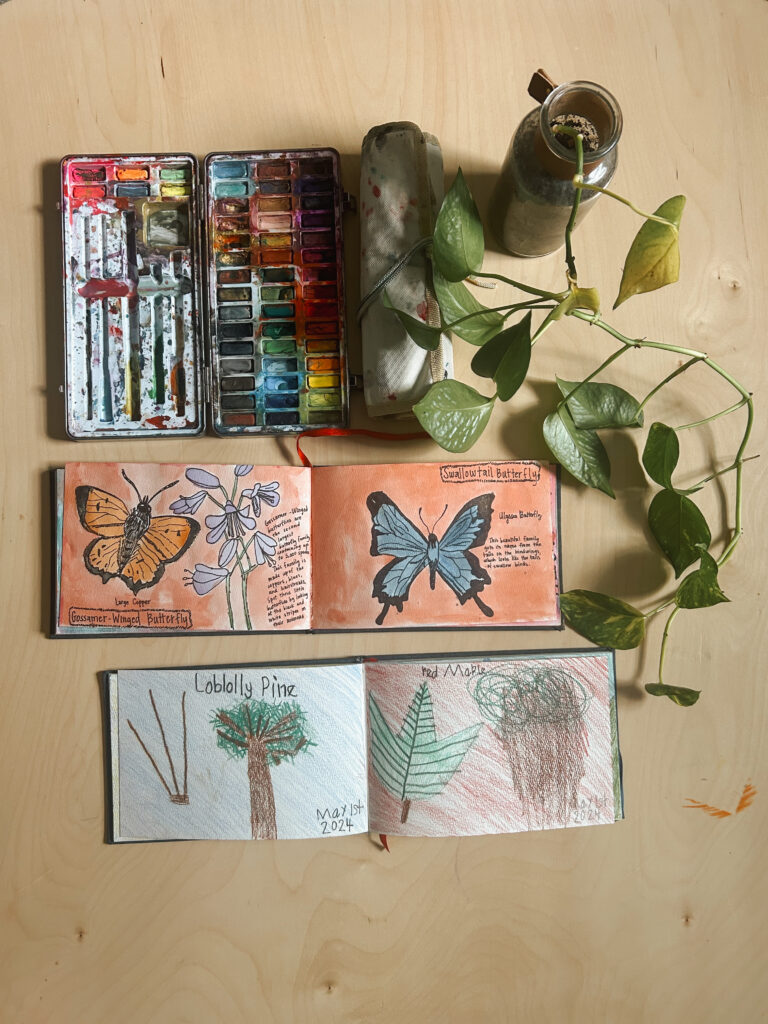
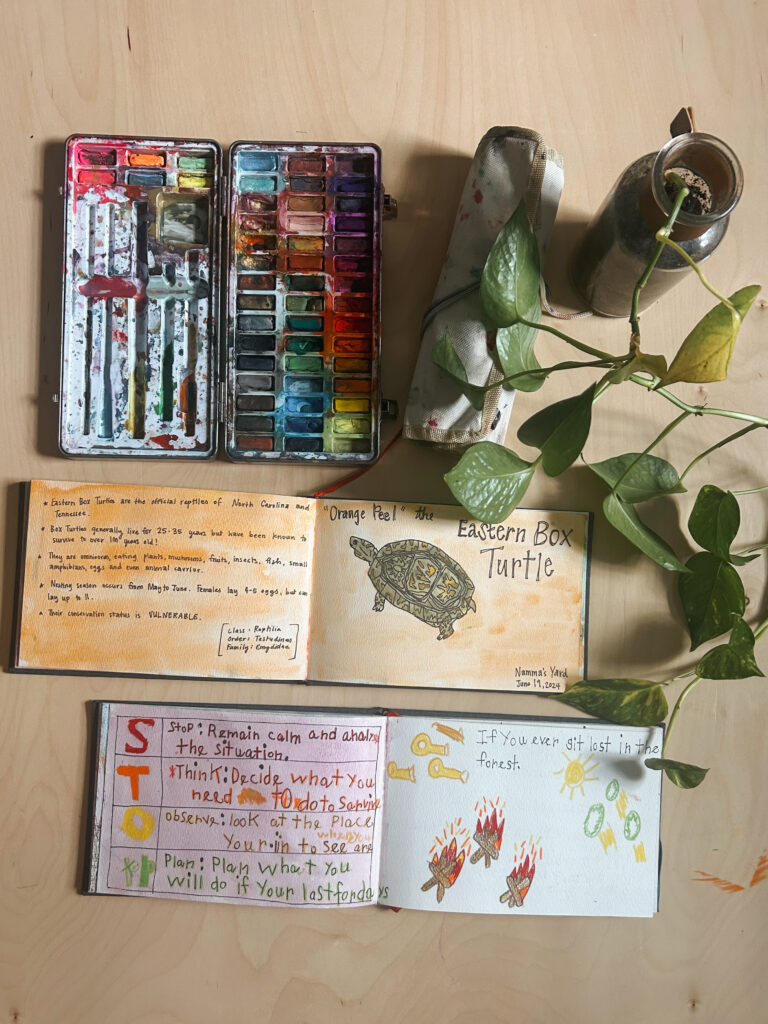
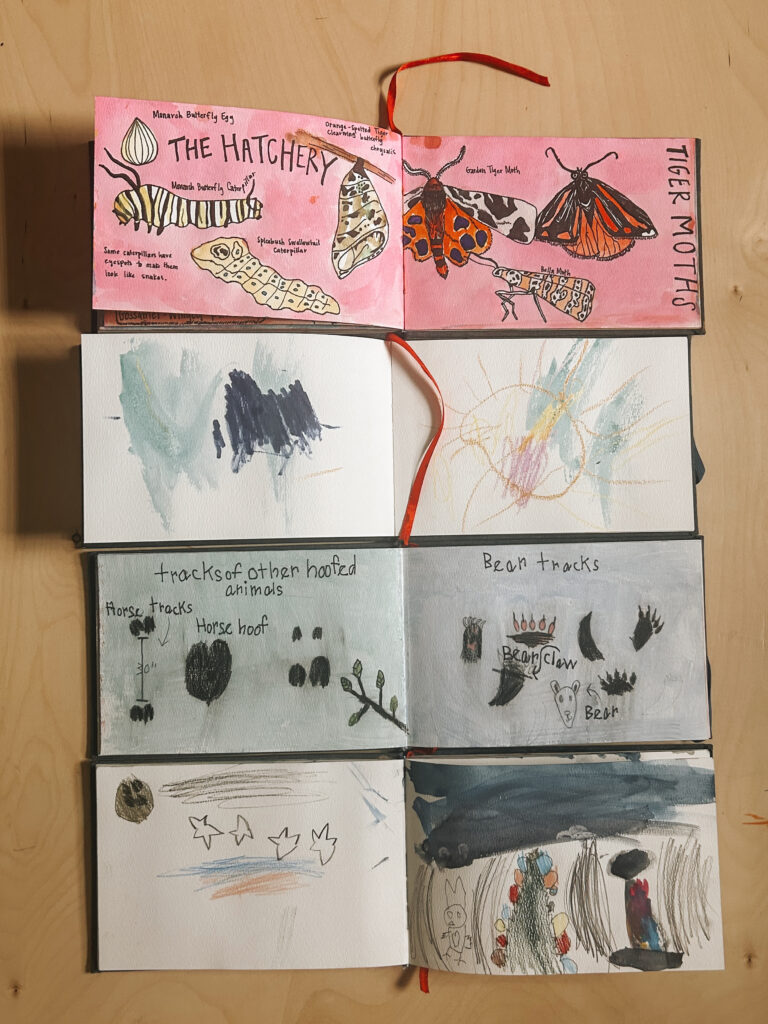
Science
Most of our science will be done through nature lore and nature study, but about once per month, we will be doing a science project from Science Art and Drawing Games for Kids. They are simple and fun science experiments that require few materials and take little time.
Worship through the Arts
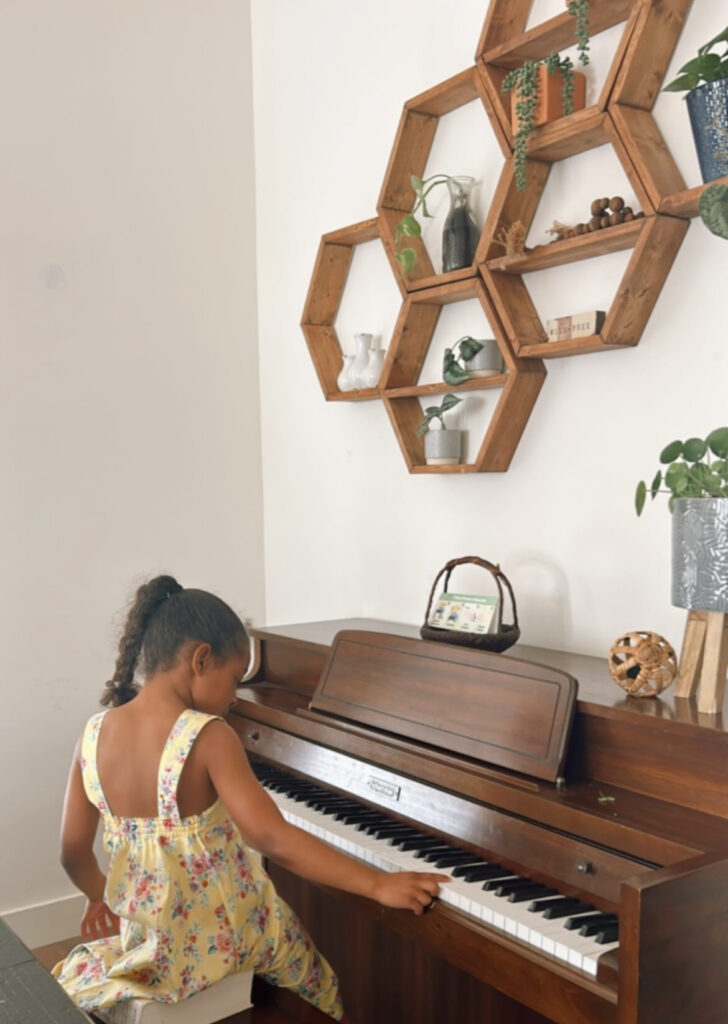
“Praise” might be a more suitable name for this pillar. While we realize that the term “worship” can really be anything that gives God glory and is not restricted to music, that is really what we are referring to here. This section includes the Arts, Hymns, Instruments, and Voice lessons. We feel strongly convicted as a family that the arts should display the glory of God. There is no reason that the most incredible painters, sculptors, architects, singers and musician shouldn’t be Christians. I once heard someone say that just as secular “art” or “entertainment” often pulls Christians into listening and watching things that DON’T honor God and leads them into sin, Christian art and entertainment should pull unbelievers to worship and honor God because of the sublime quality, beauty, caliber and creativity of a Holy Spirit-filled believer or group of believers. People filled with the Spirit of the Creator of the Universe should be the most creative people in the world. Amen?
Composer, Painter and Poet Study
We will be using A Gentle Feast’s Morning Time to study composers, painters and poets. The painters and composers we will be learning about are: DaVinci, Vermeer, Claudio Monteverdi, Velazquez, and Henry Purcell. The poets we will be studying are: Edward Lear, John Donne, and Shakespeare. A Gentle Feast also provides a poem for the child to memorize and recite at the end of each term (12 weeks).
Hymn Study
Once again, we will be learning hymns using A Gentle Feast’s Morning Time. There are two hymns to be learned per term, resulting in six hymns memorized within a year.
Instrument and Voice Lessons
This year, we will continue learning piano from Hoffman Academy, which is completely free and all online. My kindergartner and my 3rd grader will both be taking lessons. For singing, we will continue with Sing Solfa. This will take place during our Afternoon Tea Time Collective, which will happen 3 times per week.
Art
We will continue drawing, watercoloring and using different mediums for our nature journal and notebook entries, giving the children multiple opportunities to be creative in their learning time and grow in their creative skills. As noted before, our Science Projects are done through drawing and art as well, giving yet another mode of creativity.
Trades and Skills
There are more reasons that I can say here on why trades and skills are one of the pillars of our homeschool. Trades and skills not only bring craft, beauty and efficiency to a home, but also provide so many opportunities for a career, side job or hobby! Whether it’s baking sourdough, building a table, sewing a quilt or binding a book, working with your hands blesses the crafter and the one you’re crafting for. Let’s say my daughter wants to be a missionary, and is raising money for her first trip. She can always rely on her knowledge in various trades to support her- she can start a side business of baking bread, she can do woodworking and DIY projects for friends in her community. She can also use these trades and skills as a ministry, cross stitching for a friend or sewing something beautiful for an elderly person in her neighborhood. If/when she settles down into a home and perhaps a family of her own, she will have these skills to make a beautiful home. In this generation, much of our idle time is spent consuming- whether it be television or social media. My husband and I want to raise creators who knit for a loved one in their spare time, can cook a hot meal for someone who needs comfort, and can build/create for their own home instead of having to purchase everything at retail price. The more trades and in-home skills our children can learn, the better!
As an aside, we also believe that trades and skills will be necessary as we approach the last of the last days. If/when the Church in America ever has to go completely underground, and/or is unable to buy/sell, trades and skills will be necessary to exchange and share within the Body of Christ. If we are unable to buy clothing, who will make them? If we are unable to buy furniture, who will make it? If are unable to buy from restaurants and grocery store, who can cook from scratch using home grown ingredients? As I said before, this time might not come in my children’s lifetime. But perhaps it comes in their children’s, or their grandchildren’s. Passing these skills from generation to generation starts with us. Even though we weren’t taught them ourselves, we are learning WITH our children, and becoming so much more well-rounded people because of it!
Because my children are still pretty young, our trades and skills are starting with simple handicrafts and work within the home.
Handicrafts
The handcrafts, or skills, we will be working on this year are hand-sewing and cross-stitching. Every Monday, the children will be working on hand-sewing a small quilt for their dolls. In addition, my 3rd grader was gifted a cross-stitch kit for her birthday from her best friend. So they often FaceTime one another and work on their cross-stitching projects together. It’s pretty darn cute- I must say.
While this won’t be on a strict schedule, the children will also spend a ton of time with me in the kitchen, baking with sourdough and cooking day-to-day meals. They are currently learning how to put together their own lunches, which has been fabulous.
Another handicraft that they have been working on is called melting beads. They can make anything from a cupcake to a giraffe with these little beads. They make little keychains with them or just gift them to friends. While this is more of a just-for-fun craft, it’s still getting them in the habit of working with their hands and blessing others with their creations. I’m all for it.
Gardening
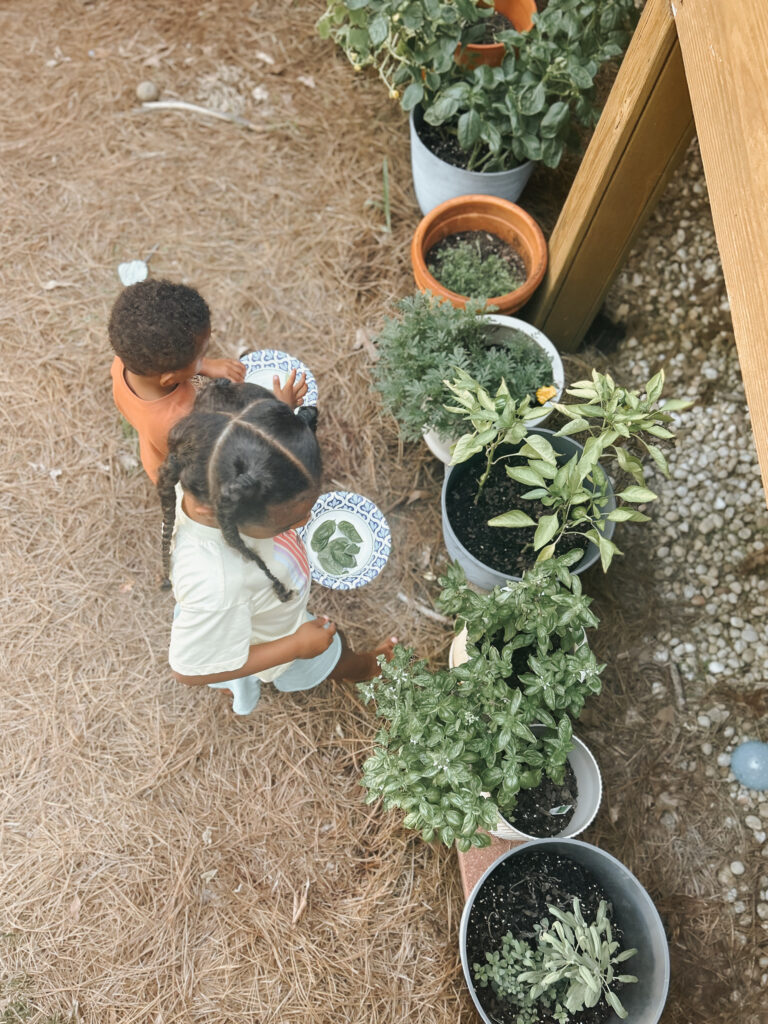
I’ve dreamed of a farmhouse with acres of pollinator gardens and vegetables for years, but that’s not our current season. For now, we have a few pots beside the back porch, and the children are still learning the very same skills. They are learning the Biblical principles of planting and watering, tending soil and nurturing the plant. They are learning how delicious a fresh bell pepper is, and how satisfying it is to top our pizzas with basil from our backyard. Even if all we ever have is small back porch gardens, our children can still learn how to grow their own food.
Language
The fifth pillar in our homeschool is language, which includes reading, writing, foreign language, and public speaking. Here is how we are honing in this year:
Reading
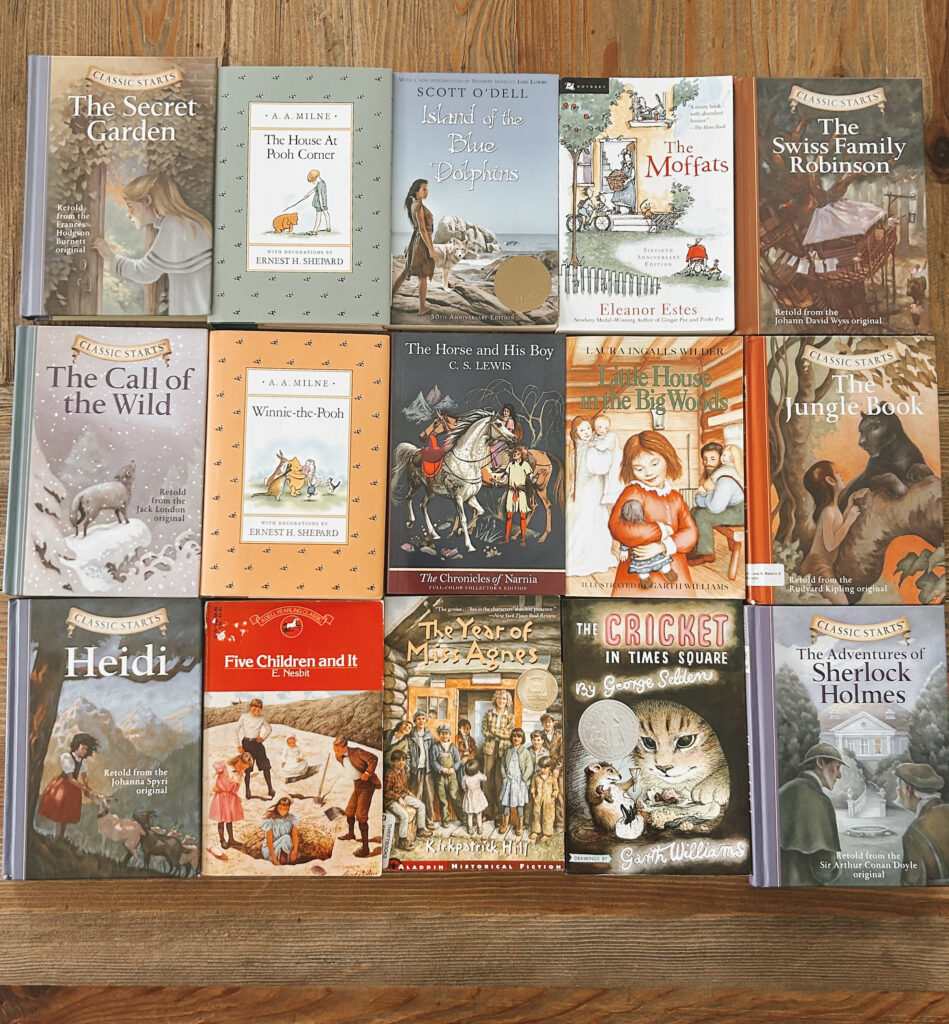
Because we rarely use textbooks, almost all of our subjects are taught through great books. Whether it be for history, geography, nature study, poetry or Church history, I will be reading aloud every single day. Since I am outlining the books I’m using for each subject elsewhere in this post, I will focus here on literature itself. Three times a week, we will be having what we call Tea Time Collective, which will happen after lunch and outdoor play at around 3pm. During tea time, I will be reading from our family read-aloud. As I read, the kids can color, play with melting beads, or do something equally as quiet. Here are some of the read-alouds I’m hoping to get through this school year.
- Winnie-the-Pooh by A.A. Milne (audio book)
- The House at Pooh Corner by A.A. Milne
- Heidi by Johanna Spyri (audio book)
- The Blue Fairy Book (select stories)
- The Little House on the Prairie series
As for individual reading, my kindergarten student will be working through the Dash Into Reading books. We are creating a little reading chart for her, and once she has read a certain amount of books (we’re thinking 15), she will get a special date day with her daddy. My 3rd grader saw the idea and wanted one for herself too, of course. So Lavender will also have a reading chart, where once she finishes a certain number of chapter books, she will get a date day with Daddy as well. She usually reads her chapter books while we are in the car (weird to me, as I’d get carsick!), or before falling asleep at night. Here are some of the books she will be working through this year:
- Pippi Longstocking by Astrid Lindgren
- The Secret Garden (Classic Starts) by Frances Hodgson Burnett
- The Adventures of Sherlock Holmes (Classic Starts) by Sir Arthur Conan Doyle
- The Silent Stranger: A Kaya Mystery by American Girl
- The Jungle Book (Classic Starts) by Rudyard Kipling
- The Cricket in Times Square by George Selden
Writing
For writing, we will be using more of an organic process. On Monday’s, we do “Mail Monday,” where the children write a letter to a friend or family member. On the other days of the week, their writing will come through nature journaling and notebooking. Natural spelling, sentence structure and handwriting happens during the notebooking process. We will not be using a specific grammar or spelling curriculum this year. I do have Sequential Spelling Volume 1, in case I see that Lavender really needs more spelling help. I love notebooking, nature journaling and letter writing, because it can be done as a family and tailored to each level. For example, my kindergartener may write one sentence, which I will write first and she will copy (usually in all caps). My 3rd grader will create her sentences by herself needing some spelling and grammar help along the way. My toddler will draw a picture.
My 3rd grader will also be continuing with her cursive this year, using Cursive Kickoff by Handwriting Without Tears.
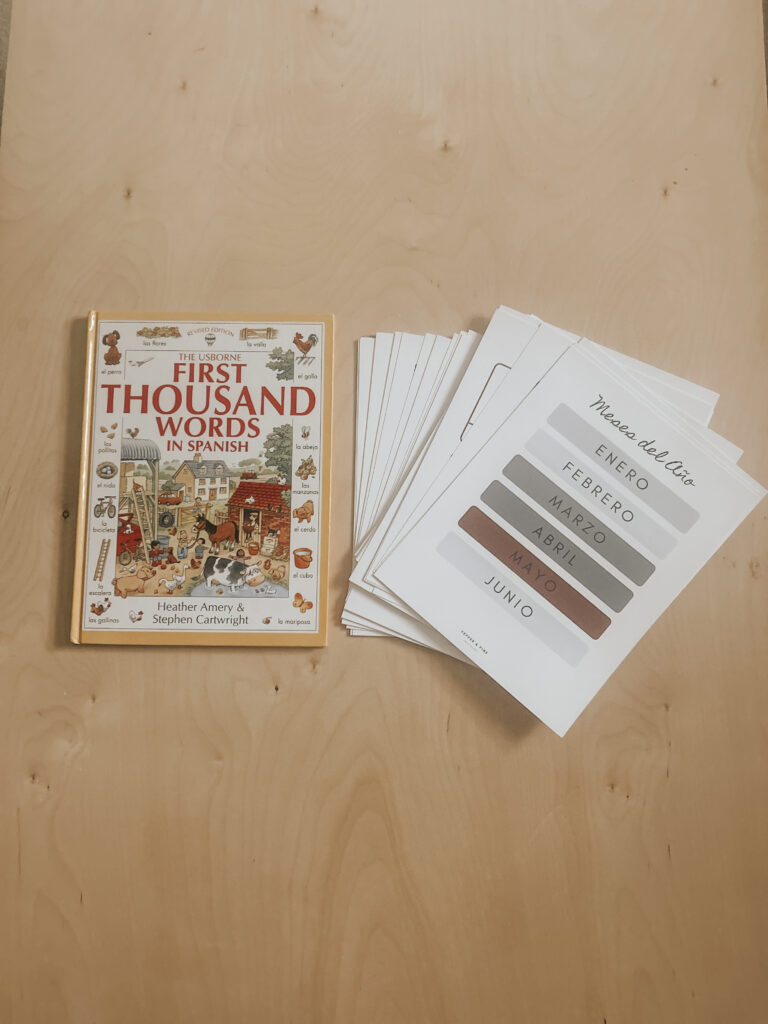
Foreign Language
We will be doing Spanish this year during our Morning Time. We will learn a new phrase or set of words each week, practicing them throughout the week. I have a Spanish resource from Pepper & Pine Montessori (basically a ton of flashcards), and I also will be using The Usborne First Thousand Words in Spanish. Because I do remember quite a bit of Spanish from school, this will be fairly simple for me. Consistency ad follow-through will be the hardest part. I’m hoping this will take only five minutes per day.
Public Speaking
As I mentioned earlier in this post, the children will be reciting Scripture and poetry throughout the year as part of their Morning Time and Bedtime routine. This will help them enunciate their words, use the proper cadence in their rhyming, and gain confidence.
Wellness and Fitness
This is not something we have specific curriculum for, but it is absolutely something we feel called to be growing in each year. Teaching our children to steward their bodies as temples of the Holy Spirit now will be the building blocks to doing the same as adults. Our morning prayer walks are a source of exercise, as well as weekend hikes as a family. We are also considering enrolling our kindergartner Lyon in flag football this year, and our oldest Lavender into basketball. Other than that, cooking nourishing meals as a family, working out together and exploring nature together is how we are achieving this pillar this year.
Critical Thinking
This is where we really dig into history, geography and math. Studying the history of people, communities and nations who feared God and those who didn’t, the choices they made and how it impacted the world makes for a lot of great conversation and much critical thinking. Geography, which is simply the study of people and places, does the same. Mathematics, while always arriving at the same answer, requires understanding and conceptual knowledge. The following is how we will be digging into each this year.
History
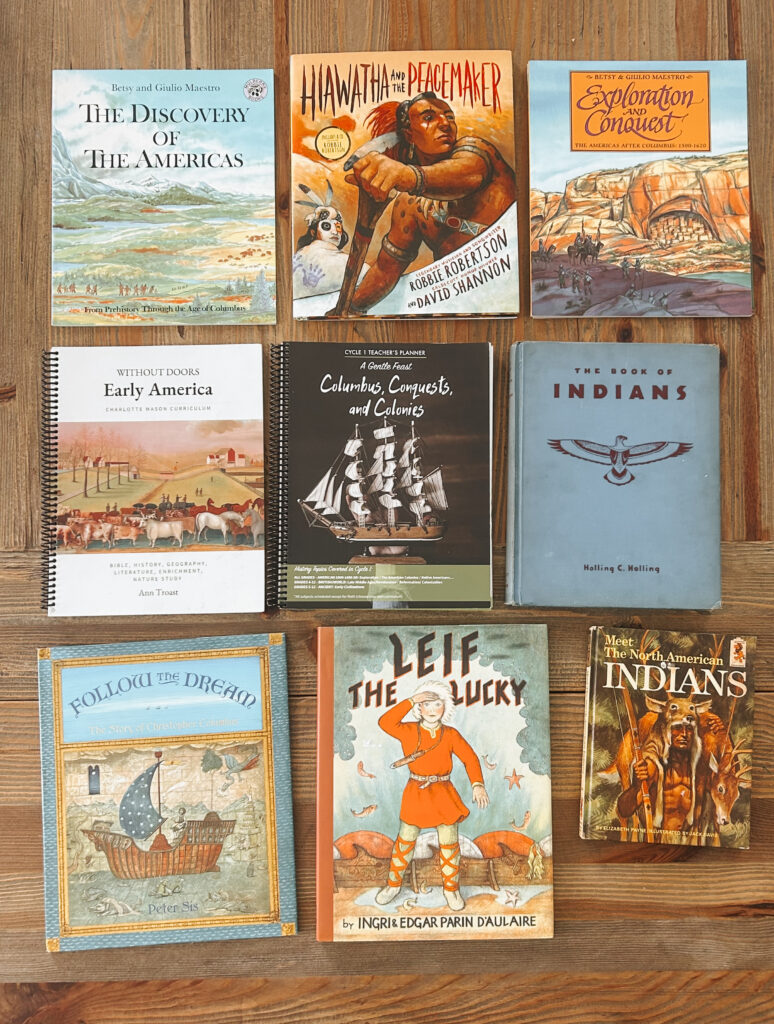
For History, I am actually combining two different curriculums: Without Doors Early America and Cycle 1 of A Gentle Feast. We will be continuing to study Native Americans (we started over Summer by reading the Kaya series by American Girl), as well as the history of the 1600s. We will read living books and record what we’re learning in our Book of Centuries and our notebooks.
Geography
We will be using the U.S. Geography K-3 Pack from Beautiful Feet Books this year. It will take us through all 50 states using maps and great living books. It gives you the option to do 1 lesson per week for a one-year study, or 2 lessons per week for one semester. We are opting for once a week on Wednesdays.
In addition, Lavender will be reading Cross Country Geography independently each Friday. It’s about a family road tripping across the country and will hopefully bring even more life to the subject. The chapters are only about 2-3 pages each.
Math
For my 3rd grader, we will be using Math with Confidence 3. Lavender is loving Math with Confidence so much that she couldn’t wait for the school year to begin and cracked it open during summer! Likewise, we will be going through Math with Confidence K for my kindergarten student.
In Conclusion
This may very well be my longest blog post. I’m finding that blogging is just as much of a journal entry for me as it is sharing with others. Writing everything down here solidifies it in my mind and reminds me of the “why.” I truly hope that as you read, you get inspired to seek the Holy Spirit for your homeschool’s pillars. As you can see, they really are the framework for everything we choose regarding resources and curriculum. The pillars dictate how we spend our time, what we say “yes” and “no” to. If you’re interested in my workbook, A Spirit Led Guide to Homeschooling, you can find it here. It will help you seek the Holy Spirit’s blueprint for your home so that you never have to question or second-guess. God cares about the details, the education of your children being a huge one!
I am working on a Part Two to this blog, which will outline my daily and weekly rhythm. While our rhythms change constantly, I will share how we are planning to fit all these beautiful subjects into one week, without it feeling like too much. If you’re interested in Part Two, stay tuned! I should have it out within a week.
I’m praying blessings over your homeschool year, wherever you are. What a joy that we get to disciple our children at home, training them up in the way that they should go, and learning right alongside them. It’s truly become one of the greatest delights of my life. May we revel in each day of this homeschool year, mamas!
Thank you so much for reading. Until next time!
Reading this has helped me tremendously for my child’s reading list as well as a deeper understanding that it’s not just about right now it’s about generation to generation. Thank you
Oh, I love this! For me it’s so much easier to start with a big picture vision and then whittle it down to each week!